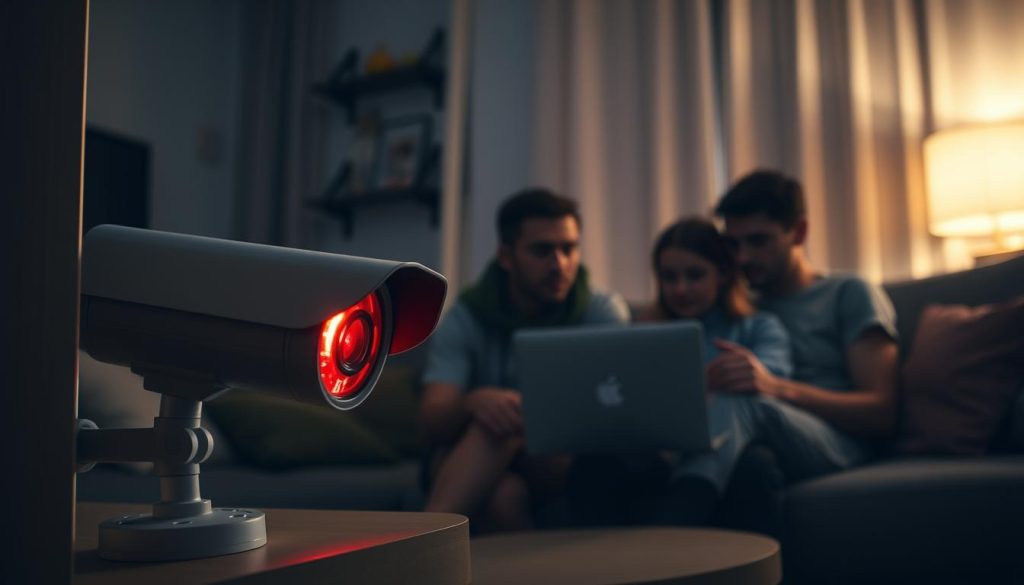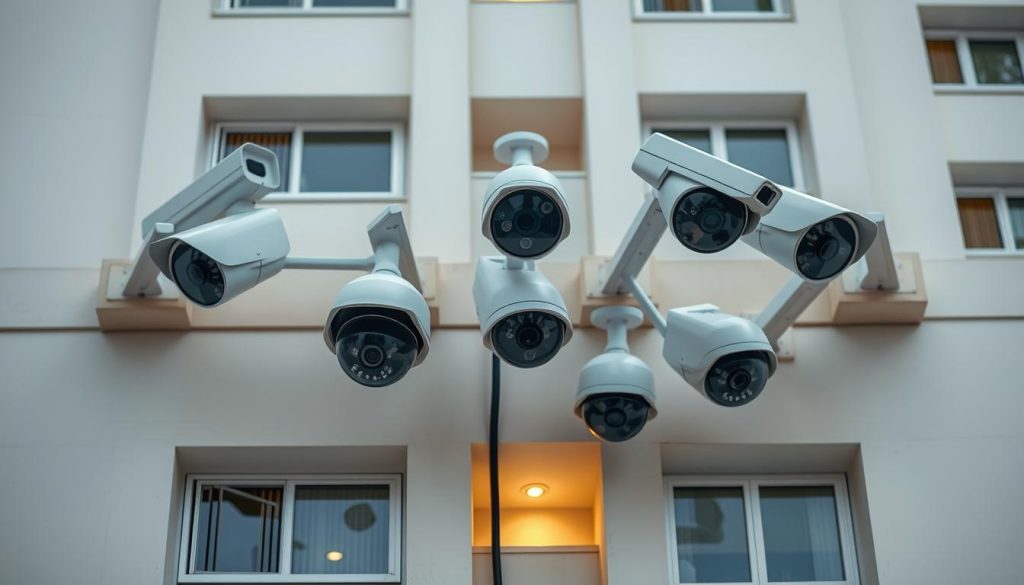Many Singapore residents seek security solutions for their homes, especially with rising concerns over parcel theft. CCTV cameras offer peace of mind, but rules apply for HDB properties.
HDB permits outward-facing devices if placed within the gate or external front door. Corridor-facing units require town council approval, a process taking 1-2 weeks with six-month validity. Smart doorbells with recording features are gaining popularity as legal alternatives.
Recent cases, like Ms. G’s stolen laptop mat, highlight how surveillance footage aids investigations. Balancing security needs with neighbor privacy remains crucial for compliance.
Key Takeaways
- HDB allows outdoor cameras with specific placement rules.
- Approval is needed for corridor-facing devices.
- Smart doorbells serve as compliant alternatives.
- Footage has proven effective in theft cases.
- Respect privacy to avoid disputes.
Is It Illegal to Install CCTV Outside HDB Flat? Understanding the Rules
Singapore’s public housing authorities enforce strict guidelines for residential security devices. Compliance ensures both safety and neighborly harmony, with distinct rules for private and shared spaces.
HDB and Town Council Regulations
The HDB permits devices within private property boundaries, such as gates or doors. For common corridors, written approval from the town council is mandatory—a process taking 1–2 weeks. Ang Mo Kio Town Council, for instance, requires permits even for smart doorbells in shared areas.
Placement restrictions prevent intrusive surveillance. Cameras must avoid direct views of neighbors’ windows or doors. Violations may trigger complaints under the Protection from Harassment Act.
Penalties for Non-Compliance
Unauthorized installations risk fines up to $5,000, as reported by The Straits Times. Non-compliant setups face forced removal, with repair costs billed to the homeowner. In 2022, 140 complaints were filed—a drop from previous years, reflecting stricter enforcement.
Proactive approval avoids legal headaches. Homeowners should consult their town council for area-specific regulations before installing CCTV.
Recent Changes to CCTV Laws in Singapore
Recent updates to surveillance laws are reshaping how residents protect their homes. The May 2023 policy shift removed mandatory approval requirements for devices mounted inside flats. This change reflects growing demand for accessible security solutions.
Simplified Approval Process
Before 2023, homeowners needed written consent for any corridor-facing devices. The new rules eliminated this step for indoor installations, cutting wait times from 14 days to immediate setup. Town councils still regulate external placements facing common areas.
Market data shows a 33% surge in camera sales since 2021. SafeTrolley reports 70-90 monthly inquiries from residents seeking compliant setups. Retailers now highlight “HDB-approved” models to guide buyers.
Impact on Homeowners
The streamlined process comes with important limitations:
- Only one device permitted per household in corridor areas
- Permits remain valid for six months (renewable)
- Cameras must not capture neighbors’ private spaces
Security experts recommend checking with local town councils before mounting devices. While indoor setups gained flexibility, outdoor installations still require approval. Proper placement avoids privacy complaints while maintaining effective monitoring.
Types of CCTV Cameras Suitable for HDB Flats
Modern security solutions blend technology with HDB compliance needs. Residents can choose between wired and wireless systems, each offering unique benefits. Smart doorbells also provide legal alternatives for doorstep monitoring.
Wired vs. Wireless Cameras
Wired systems transmit data 30% faster, ideal for real-time alerts. They require drilling but deliver uninterrupted power and reliability. Brands like Arlo Pro 4 suit permanent setups with weatherproof designs.
Wireless devices use adhesive mounts, perfect for renters. A 256GB SD card stores 21 days of footage, and batteries last 2–6 months. However, they depend on Wi-Fi stability—a concern in dense HDB blocks.
Smart Doorbells as an Alternative
Xiaomi and Ring doorbells fit existing HDB slots without modifications. These devices combine video recording with intercom functions. Eufy’s dual-camera model even replaces traditional peepholes.
Magnetic mounts offer renter-friendly installation. “Smart doorbells reduce corridor disputes by focusing only on your doorstep,” notes a First Solutions security expert. Their compact size avoids town council approval in most cases.
Key Features to Look for in a Home CCTV System
Effective home monitoring depends on selecting cameras with advanced capabilities. Prioritizing these features ensures reliable security and compliance with local regulations.
Night Vision and Wide-Angle Coverage
Cameras with night vision below 0.1 lux capture clear footage in low light. A 170° wide-angle lens eliminates blind spots, crucial for corridor or doorstep coverage.
Higher resolutions like 4K demand more storage but provide sharper details. For evidence validity, timestamps must be embedded in recordings.
Storage Options: Local vs. Cloud
Local storage via 256GB microSD cards avoids monthly fees, while cloud subscriptions ($4.99–$14.99) offer remote access. PDPA-compliant encryption safeguards data in both systems.
“Always enable two-factor authentication for cloud accounts. Weak passwords expose footage to breaches.”
Wi-Fi extenders may be needed for stable connectivity in HDB blocks. Balance cost, convenience, and security when choosing storage.
Step-by-Step Guide to Legally Installing CCTV
Homeowners must follow specific steps for compliant camera installations. From paperwork to positioning, each detail ensures adherence to HDB rules while maximizing security.
Obtaining Town Council Approval
Begin by gathering required documents: floor plans, camera specifications, and neighbor consent forms. Ang Mo Kio Town Council provides templates for streamlined applications.
The process typically takes 3–4 weeks:
- Week 1: Submit forms with a $20–$50 fee (varies by district).
- Week 2–3: Council reviews device placement and coverage maps.
- Week 4: Receive permit with six-month validity.
“Professional installers like I-Secure Solutions pre-check setups against local regulations, reducing rejection risks.”
Choosing the Right Placement
Mount cameras at least 1.5m high to deter vandalism. Use 15°–45° brackets to focus on your doorstep, not neighboring units. Ideal coverage avoids corridors and windows.
For shared areas:
- Angle devices downward to monitor only your flat entrance.
- Test views using a smartphone app before finalizing mounts.
- Renew permits biannually to maintain compliance.
Companies like SafeTrolley offer free audits to verify placements. Properly install cctv cameras once to avoid costly adjustments later.
Privacy and Ethical Considerations
Balancing home security with community harmony requires careful consideration of privacy laws. While surveillance systems deter crime, they must respect legal boundaries and neighbor relationships. Singapore’s regulations provide clear frameworks for responsible monitoring.

Respecting Residential Boundaries
The Community Disputes Resolution Act defines “reasonable surveillance” as monitoring only your property without intruding on others’. A 2022 case saw a $7,500 fine for cameras capturing a neighbor’s bathroom window.
Best practices include:
- Angling devices away from adjacent units’ doors/windows
- Providing written notices to immediate neighbors
- Using privacy masks to blur shared corridor areas
Security expert Mark Lim advises: “Position cameras downward-facing at entranceways. This shows good faith while maintaining coverage.”
Handling Recorded Data Responsibly
The Personal Data Protection Act (PDPA) mandates clear signage for any camera capturing public areas. Footage must be deleted within 72 hours unless required for police investigations.
Cybersecurity measures are equally important:
- Enable WPA3 encryption on wireless systems
- Change default admin passwords immediately
- Use VPNs for remote access to live feeds
“Redact unrelated individuals’ faces when sharing footage online. The AVS cat-throwing case established this as best practice for evidence handling.”
Common Mistakes to Avoid When Installing CCTV
Simple missteps during setup can transform protective devices into legal liabilities. A 2021 survey revealed 34% of DIY installations violated angle regulations, often triggering neighbor complaints or town council interventions.
Overlooking Legal Requirements
Many homeowners skip permit applications, risking $5,000 fines. Common application rejections involve incomplete forms or missing floor diagrams showing camera coverage zones.
Critical oversights include:
- Audio recording without consent, violating PDPA laws
- Infrared glare disturbing adjacent units at night
- Thermal cameras in food preparation areas (banned under AVA guidelines)
“Covert devices disguised as smoke detectors often breach spy camera laws. Visible, properly declared systems prevent legal trouble.”
Poor Camera Placement
Positioning errors account for 60% of neighbor disputes. Prohibited zones include stairwells, lift lobbies, and playground sightlines where privacy expectations are highest.
A Jurong West case study showed how a 15° misalignment:
- Captured a neighbor’s laundry area
- Triggered Protection from Harassment Act proceedings
- Required $1,200 in repositioning costs
Professional installers recommend test recordings before finalizing mounts. This verifies the field of view stays within property boundaries.
How CCTV Enhances Home Security in HDB Flats
Visible security measures create psychological barriers against potential intruders. Studies show marked improvements in both actual protection and perceived safety when monitoring systems are present. These solutions serve dual purposes—preventing incidents before they occur and providing crucial documentation when needed.
Crime Prevention Through Visibility
The mere presence of cameras reduces corridor theft by 40%, according to 2023 police data. Insurance providers recognize this deterrent effect, offering 15-20% premium discounts for homes with approved systems.
Key prevention benefits include:
- Real-time alerts for suspicious activity near doorsteps
- Documentation of delivery personnel and visitors
- Community-wide deterring crime effects in high-traffic areas
Forensic Value in Investigations
Timestamped footage helped resolve Ms. Lee’s stolen plant case within 48 hours. Such evidence follows strict Chain of Custody protocols for court admissibility:
“Uninterrupted recording logs with embedded metadata carry maximum evidentiary weight. Always maintain original files without edits.”
Over 4,095 crimes were solved using residential surveillance footage in 2020. A recent SPF survey shows 91% public support for these systems in crime-prone neighborhoods.
Final Tips for a Secure and Compliant CCTV Setup
Smart surveillance practices protect property while fostering neighborhood trust. Monthly maintenance like lens cleaning and firmware updates preserves camera effectiveness.
For reliable devices, consider Reolink (budget) or Hikvision (premium). Safe City Solutions offers 24/7 monitoring at $29.99/month for extra peace of mind.
Remember key compliance points:
- Renew permits before expiration
- Verify camera angles quarterly
- Notify neighbors about devices
Annual professional audits catch potential issues early. Sharing communal footage builds goodwill when incidents occur.
Upgrade systems every five years for optimal performance. Join HDB’s Telegram alert group for regulation updates to keep home safe and compliant.

